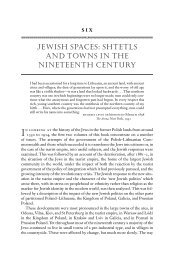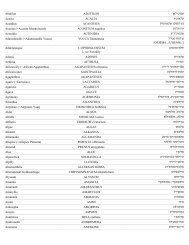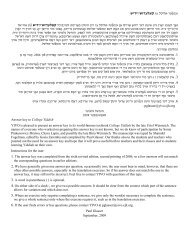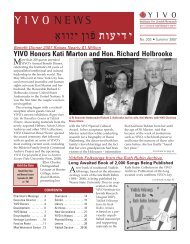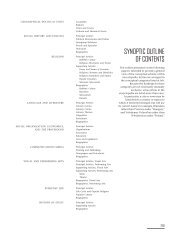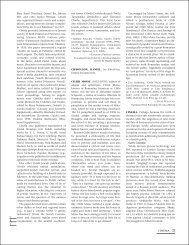t any plant names in Yiddish - YIVO Institute for Jewish Research
t any plant names in Yiddish - YIVO Institute for Jewish Research
t any plant names in Yiddish - YIVO Institute for Jewish Research
Create successful ePaper yourself
Turn your PDF publications into a flip-book with our unique Google optimized e-Paper software.
VIII<br />
˘È„”È Ôȇ ËÏÚÂÂ≠ÔÒ˜ÈÂÂÚ‚ È„ Ÿ ¯ÚËÎÚ˘ È΄¯Ó<br />
1. Preface<br />
Until its publication, Plant Names <strong>in</strong> <strong>Yiddish</strong> (hence<strong>for</strong>th: PNY) went<br />
through several stages. After the publication of a smaller project, "Names<br />
of trees and shrubs," whose theoretical part was published <strong>in</strong> the journal<br />
Yidishe Shprakh (vol. XXVI, 1966, pp. 56-80), objections were raised: why<br />
only trees and shrubs? How about flowers? How about vegetables, especially<br />
those virtually unknown <strong>in</strong> Eastern Europe? And we ourselves added:<br />
How about the aquatic <strong>plant</strong>s the pedagogue and writer A. Golomb<br />
wrote about <strong>in</strong> <strong>Yiddish</strong>? And the mushrooms and toadstools? And the medic<strong>in</strong>al<br />
<strong>plant</strong>s – how can one understand the <strong>Yiddish</strong> booklets on folk medic<strong>in</strong>e<br />
if we don't clarify the mean<strong>in</strong>gs of the various botanical terms <strong>in</strong><br />
them? And how can we possibly ignore the <strong>in</strong>dustrial <strong>plant</strong>s about which<br />
quite a bit was written <strong>in</strong> <strong>Yiddish</strong>, especially <strong>in</strong> the Soviet Union? And generally<br />
the botanical terms that were taught <strong>in</strong> <strong>Yiddish</strong> schools <strong>in</strong> Eastern<br />
Europe?<br />
By thus expand<strong>in</strong>g the scope of our project we soon realized that the<br />
result would just be overwhelm<strong>in</strong>g, beyond the capabilities of an <strong>in</strong>dividual.<br />
There<strong>for</strong>e it was decided to leave out m<strong>any</strong> terms <strong>in</strong> the fields of phytomorphology,<br />
phytoanatomy, phytophysiology, phytoecology, phytogeography,<br />
and phytogenetics, as well as paleobot<strong>any</strong>, all of which would be left <strong>for</strong> a<br />
later hoped-<strong>for</strong> encompass<strong>in</strong>g project, "Term<strong>in</strong>ology of Life Sciences <strong>in</strong><br />
<strong>Yiddish</strong>." As a result, what we were left with <strong>in</strong> the f<strong>in</strong>al analysis was just<br />
<strong>plant</strong> <strong>names</strong>, i.e., phytotaxonomic term<strong>in</strong>ology of a descriptive and prescriptive<br />
nature, as well as a select number of morphological terms found<br />
<strong>in</strong> various <strong>Yiddish</strong> manuals of bot<strong>any</strong> and agronomy<br />
Authorship. Although PNY has only one compiler, it is <strong>in</strong> essence<br />
largely a collective work. It could not have been accomplished without the<br />
m<strong>any</strong> compilers of <strong>Yiddish</strong> textbooks and readers on the natural sciences<br />
and geography, the translators and authors of travelogues, the term<strong>in</strong>ologists<br />
and lexicographers, the dialectologists and collectors of regional lexicon,<br />
prose writers and poets with an eye <strong>for</strong> natural phenomena. Their <strong>in</strong>di-



